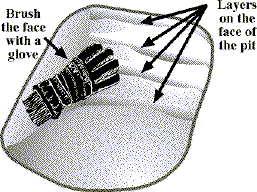Home | Hasty Pits
Why/How to dig a hasty pit?
- The pit provides information to evaluate the questions: are there slab layers,how large and extensive are the slabs, how well are the slabs bonded to other layers, what will it take to make the slabs fail.
- In the pit you will be able to identify snow layers, snow types, layer cohesiveness and snow density.
- Pits can identify buried surface hoar and faceted snow layers.
- Never dig a hasty pit where you might trigger a slide. The site should be safe and representative of the slopes you are really evaluating. Your pit site should have the same elevation, slope angle and aspect as the slopes of interest.
- A hasty pit can be dug and analyzed in 15-20 minutes with practice. Make the pit about 3 feet wide. Dig to ground if practical but go at least 4 to 6 feet deep. Digging the pit will give you information about the layering of the snow so pay attention.
- Make the uphill face vetical and smooth. Observe this face for layers by brushing the face with your glove. Check the hardness of the layers by pressing into the snow. If you can easily push in your fist the snow is "Very soft"; four fingers is "Soft"; one finger is "Medium"; a pencil is"Hard" ; a knife blade is "Very hard" snow.
- The hasty pit is not a stability evaluation. Informed decisions can only be reached by combining input from weather, terrain, snowpack, skier capabilities and information provided by your hasty pits.
Home | Hasty Pits
| PageTop

